Buy
at AllPosters.com



MADRID
- ATOCHA STATION (AVE) FEATURED HOTELS
|
|

| (Also
convenient for Parque del Retiro
and Thyssen-Bornemisza, Reina
Sofia & Prado Museums)
Atocha Station
(Spanish: Estación de Atocha) is the largest railway station in
Madrid. It is the primary station serving commuter trains (Cercanías),
intercity and regional trains from the south, and the AVE high speed trains
from Barcelona (Catalonia) and Seville (Andalusia). These train services
are run by the Spanish national rail company, Renfe. The station
was Madrid's first railway station. It was inaugurated on 9 February 1851
under the name Estación de Mediodía (Atocha-Mediodía
is now the name of an area of the Arganzuela district, and means in old
Spanish south). After the building was largely destroyed by fire, it was
rebuilt and reopened in 1892. The architect for the replacement, in a wrought
iron renewal style was Alberto de Palacio Elissagne, who collaborated with
Gustave Eiffel. Engineer Henry Saint James also took part in the project.
This old building was taken out of service in 1992 and converted into a
concourse with shops, cafés, a nightclub, and a 4,000 m² covered
tropical garden. A modern terminal by Rafael Moneo, designed to serve the
new AVE trains to Seville, was added to the complex.
The main lines
end in the new terminal; commuter train platforms are located underground,
at the ingress to a rail tunnel extending northward under the Paseo de
la Castellana. The station, located on the Plaza del Emperador Carlos
V, is served by two Madrid Metro stations, Atocha and Atocha Renfe. The
latter was added when the new terminal building was constructed and is
directly linked to the railway station. The Reina Sofía museum
is in the vicinity of Atocha. The station was in the International Media
because of the 11 March 2004 Madrid train bombings. On 10 June 2004,
a virtual shrine was dedicated by the Spanish Minister of Transport. Visitors
to the attacked stations can leave a hand silhouette and a message through
special-purpose consoles. |
Search
for more Madrid Hotels
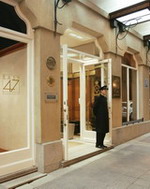 |
Hotel
Villa Real, Madrid
The Hotel Villa Real is
housed in a grand building, sensitively designed to blend with the surrounding
architecture, in the centre of the museum triangle 300 metres from the
Prado. Madrid's finest museums are on the doorstep: the Thyssen Museum
(fine art) is just 100 metres away and the Reina Sofia 400 metres. Madrid's
main square, Puerta del Sol, is also 400 metres from the hotel. Guests
can escape the hustle and bustle of the city and relax over drinks in East
47 restaurant and cocktail bar, a cosmopolitan space offering modern European
cuisine and an impressive collection of Warhols. The hotel is filled with
all kinds of art, sculptures and mosaics, and wireless Internet is available
in public areas for guests who wish to stay in touch. |
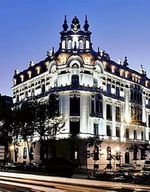 |
AC
Palacio Del Retiro, Autograph Collection, a Luxury & Lifestyle Hotel,
Madrid
Built as a palace in 1908
and converted into a hotel in 2004, the AC Palacio del Retiro is a national
heritage site, which features original sweeping marble staircases and stained
glass windows. The hotel is situated in the city centre, 300 metres from
the Prado Museum. The Reina Sofia Art Centre is 500 metres away, and the
Running of the Bulls takes place at Plaza de Toros, five kilometres away.
Guests can work out in the fitness centre and then unwind in the sauna.
Those seeking total relaxation can indulge in a variety of spa and massage
treatments, including in-room massages. Diners can enjoy modern Mediterranean
cuisine in a relaxed setting at the restaurant Indice. Before dinner, guests
can enjoy cocktails in the bar, or relax and take advantage of 24-hour
room service. Parents will appreciate the babysitting service. |
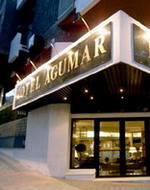 |
Hotel
Agumar Madrid
The Hotel Aqumar, Madrid
is a modern, eleven-floor wonder and is located next to the Parque Del
Retiro, just 200 meters from Atocha-Ave railway station and around the
corner from the Prado museum. Many of Madrid's finest attractions are within
easy reach of the hotel, including the Queen Sofía Art Centre, the
Thyssen-Bornemisza Art Gallery, and the Botanical Gardens. Patrons
of Hotel Agumar can relax with a drink in the bar, enjoy international
cuisine in the restaurant or hit the dance floor at the hotel's own disco.
The hotel provides 24-hour room service, and newspapers in public areas.
The hotel's 245 guestrooms are decorated in a variety of styles and feature
interactive TV with pay movies. |
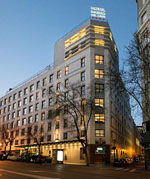 |
Hotel
Paseo de Arte, Madrid
The Hotel Paseo del Arte
is a contemporary mid-rise hotel situated in the Golden Cultural Triangle,
800 metres from El Prado, Spain's largest and most famous museum. The Reina
Sofia museum of contemporary art, housing works by renowned Spanish artists
including Goya, Picasso and Dali, is 300 metres from the hotel, while Pollock,
Rothko and Caravaggio can all be found at the Thyssen-Bornemisza Museum,
700 metres away. The famous Casa de Campo, a vast open space offering an
amusement park, cable cars and a zoo, is three kilometres from the hotel.
Madrid Barajas Airport is 15 kilometres away, with an approximate driving
time of 30 minutes. |
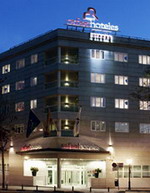 |
Rafaelhoteles
Atocha, Madrid
The modern Rafaelhoteles
Atocha is located within one-and-a-half kilometres of the "big three" Madrid
museums, the Prado, Reina Sofia and the Thyssen-Bornemiza in Madrid, Spain.
Atocha rail and metro station is 800 metres from the hotel, and Madrid
Barajas Airport (MAD) is 10 kilometres away. A five-storey white
brick hotel, Rafaelhoteles Atocha has a corner entrance. Glass doors lead
into a large, spacious lobby with marble floors, front desk, seating and
complimentary newspapers. The hotel has a terrace at the rear. El
Azafran restaurant at Rafaelhoteles Atocha offers Mediterranean and international
flavours, specialising in rice dishes. With dark red walls, cream tablecloths,
the restaurant is open for breakfast, lunch and dinner. The hotel's bar
is open for relaxing drinks. |
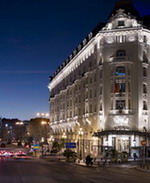 |
The
Westin Palace Madrid
Overlooking the Neptune
Fountain and its quiet plaza, the Westin Palace lies opposite the Prado
and Thyssen-Bornemisza museums and is two blocks from the Reina Sofia Art
Centre. The palatial hotel was built in 1912 on the former site of the
palace of the Duke and Duchess of Medinaceli. The entrance hall,
decorated with murals of Italian Renaissance gardens, leads through to
Rotunda Hall which is crowned with an Art Nouveau glass dome. Dining options
include international and Spanish dishes at the informal La Rotonda, and
Chinese cuisine at Asia Gallery. A complimentary breakfast is served daily.
Set in the most dramatic room of the hotel, the Palace Bar is dominated
by an Art Nouveau stained-glass dome with flower motif, from which a large
chandelier is suspended. Cocktails, and a choice of over 700 wines from
the adjoining cellar, are served here, and live piano music is played for
afternoon tea. Club Neptuno fitness centre is open round the clock and
offers rooftop views across the Buen Retiro Park. |
Search
for more Madrid Hotels
Continue
browsing Madrid hotels by area


Parque
del Buen Retiro

| The
Jardines del Buen Retiro or Parque del Buen Retiro (literally "Gardens"
or "Park of the Pleasant Retreat"), or simply El Retiro, the "Lungs of
Madrid", is the main park of the city of Madrid, capital of Spain.
The
Parque del Buen Retiro is a large and popular 1.4 km2 (350 acres) park
at the edge of the city center, very close to the Puerta de Alcalá
and not far from the Museo del Prado. A magnificent park, filled with beautiful
sculpture and monuments, galleries, a peaceful lake and host to a variety
of events, it is one of Madrid's premier attractions. The park is entirely
surrounded by the present-day city.
Close
to the northern entrance of the park is the Estanque del Retiro ("Retiro
Pond"), a large artificial pond. Next to it is the monument to King Alfonso
XII, featuring a semicircular colonnade and an equestrian statue of the
monarch on the top of a tall central core. |

Lake
and Monument at Park, Parque Del Buen Retiro, Madrid
Buy
at AllPosters.com
|


Buy
at AllPosters.com
|
The
Rosaleda rose garden. Among the many rose bushes of all kinds stands the
Fountain of the Falling Angel, erected in 1922, whose main sculpture El
Angel Caído (at the top) is a work by Ricardo Bellver (1845–1924)
inspired by a passage from John Milton's Paradise Lost, which represents
Lucifer falling from Heaven.
The
few remaining buildings of the Buen Retiro Palace, including Casón
del Buen Retiro and the Museo del Ejército, now house museum collections.
The Casón has a collection of 19th and 20th century paintings, including
art by the Spanish painter Joaquín Sorolla. The Ejército
is one of Spain's foremost Army museums and it houses "La Tizona" the sword
of the famous Spanish warrior El Cid. There are displays of armor, a cross
carried by Christopher Columbus on his sea voyage to the New World and
other artifacts.
Since
assuming its role as a public park the late 19th century, the "Parque del
Retiro" has been used as avenue for various international exhibitions.
Several emblematic buildings have remained as testimony to such events,
including the Minig building, popularly know as the Velázquez Palace
(1884) by architect Ricardo Velázquez Bosco, and the Palacio de
Cristal ("Crystal Palace"), a glass pavilion inspired by The Crystal Palace
in London, undoubtedly the gardens' most extraordinary building. |

| Built
along with its artificial pond in 1887 by architect Ricardo Velázquez
Bosco for the Philippine Islands Exhibitions, it was first used to display
flower species indigenous to the islands. The landscape-style gardens located
in the former "Campo Grande" are also a reminder of the international exhibitions
that have taken place here in the past.
The
Paseo de la Argentina, also popularly known as Paseo de las Estatuas ("Statue
Walk"), is decorated with some of the statues of kings from the Royal Palace
from the Royal Palace, sculpted between 1750 and 1753.
There
are now art galleries in the Crystal Palace, Palacio de Velázquez,
and Casa de Vacas.
In
the Retiro Park is also the Forest of the Departed (Bosque de los Ausentes),
a memorial monument to commemorate the 191 victims of the 11 March 2004
Madrid attacks. |

Crystal
Palace, Retiro Park, Madrid, Spain, Europe
Buy
at AllPosters.com
|

Activities
From
late May through early October, every Sunday at midday, the Banda Sinfónica
de Madrid gives free concerts from the bandstand in the park near the Calle
d'Alcala. The Park features an annual Book Fair. Around the
lake, Retiro Pond, many puppet shows perform, and all manner of street
performers and fortune tellers. Rowboats can be rented to paddle about
the Estanque, and horse-drawn carriages are available. |
|
top
|
Museo del Prado, Madrid
The
Museo
del Prado is a museum and art gallery located in Madrid, the capital
of Spain. It features one of the world's finest collections of European
art, from the 12th century to the early 19th century, based on the former
Spanish Royal Collection. Founded as a museum of paintings and sculpture,
it also contains important collections of more than 5,000 drawings, 2,000
prints, 1,000 coins and medals, and almost 2,000 decorative objects and
works of art. Sculpture is represented by more than 700 works and by a
smaller number of sculptural fragments. It is one of the most visited sites
in Madrid.
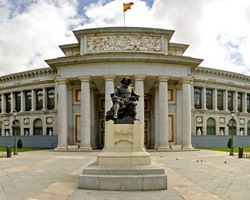 With
about 1,300 paintings on display in the museum, the museum's world class
status is secured. The Prado has easily the world's finest collection of
Spanish painting, with large numbers of the finest works of Diego Velázquez
and Francisco Goya, as well El Greco, Bartolomé Estéban Murillo,
Jusepe de Ribera, Francisco de Zurbarán, and most other leading
Spanish old masters. There are also large groups of important works by
the Dutch painter Hieronymus Bosch (a personal favorite of King Philip
II of Spain), Titian, Peter Paul Rubens, Raphael, and Joachim Patiner.
Fine examples of the works of Andrea Mantegna, Botticelli, Caravaggio,
Guido Reni, Albrecht Dürer, Rembrandt, Orazio Gentileschi, Artemisia
Gentileschi, Veronese, Hans Baldung Grien, Fra Angelico, Antonello da Messina,
Van der Weyden, Nicolas Poussin, Claude Gellée, Thomas Gainsborough,
Thomas Lawrence, and many other notable artists are also on display in
the museum. With
about 1,300 paintings on display in the museum, the museum's world class
status is secured. The Prado has easily the world's finest collection of
Spanish painting, with large numbers of the finest works of Diego Velázquez
and Francisco Goya, as well El Greco, Bartolomé Estéban Murillo,
Jusepe de Ribera, Francisco de Zurbarán, and most other leading
Spanish old masters. There are also large groups of important works by
the Dutch painter Hieronymus Bosch (a personal favorite of King Philip
II of Spain), Titian, Peter Paul Rubens, Raphael, and Joachim Patiner.
Fine examples of the works of Andrea Mantegna, Botticelli, Caravaggio,
Guido Reni, Albrecht Dürer, Rembrandt, Orazio Gentileschi, Artemisia
Gentileschi, Veronese, Hans Baldung Grien, Fra Angelico, Antonello da Messina,
Van der Weyden, Nicolas Poussin, Claude Gellée, Thomas Gainsborough,
Thomas Lawrence, and many other notable artists are also on display in
the museum.
The
best known work on display at the museum is Las Meninas by Velázquez.
Velázquez not only provided the Prado with his own works, but his
keen eye and sensibility was also responsible for bringing much of the
museum's fine collection of Italian masters to Spain.
The
Museo del Prado is one of the buildings constructed during the reign of
Charles III (Carlos III) as part of a grandiose building scheme designed
to bestow upon Madrid a monumental urban space. The building that lodges
the Museum of the Prado was initially conceived by José Moñino
y Redondo, conde de Floridablanca and was commissioned in 1785 by Charles
III for the reurbanización of the Paseo del Prado. To this end,
Charles III called on one of its favorite architects, Juan de Villanueva,
author also of the nearby Botanical Garden and the City Hall of Madrid.
The prado ("meadow") that was where the museum now stands gave its name
to the area, the Salón del Prado (later Paseo del Prado), and to
the museum itself upon nationalisation. Work on the building stopped at
the conclusion of Charles III's reign and throughout the Peninsular War
and was only initiated again during the reign of Charles III's grandson,
Ferdinand VII. The structure was used as headquarters for the cavalry and
a gunpowder-store for the Napoleonic troops based in Madrid. |
|
top
|
Thyssen-Bornemisza
Museum, Madrid
The
Thyssen-Bornemisza
Museum, or in Spanish Museo Thyssen-Bornemisza, is an art gallery near
the Prado Museum in Madrid. It is known as a part of the "Golden Triangle
of Art", which also includes the Prado and the Reina Sofia galleries. The
Thyssen-Bornemisza fills the historical gaps in its counterparts' collections:
in the Prado's case this includes Italian primitives and works from the
English, Dutch and German schools, while in the case of the Reina Sofia
the Thyssen-Bornemisza collection, once the second largest private collection
in the world after the British Royal Collection, includes Impressionists,
Expressionists, and European and American paintings from the second half
of the 20th century, with over 1,600 paintings. The competition was won
after in 1986 Baron Thyssen having tried to enlarge his Museum in Villa
Favorita and searched for a location in Europe.
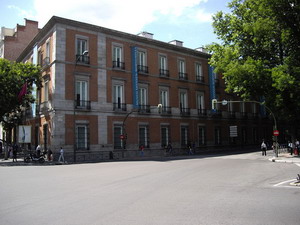 History
of the collection History
of the collection
The
collection started in the 1920s as a private collection by Heinrich, Baron
Thyssen-Bornemisza de Kászon (1875–1947) and later expanded by his
son Baron Hans Heinrich Thyssen-Bornemisza (1921–2002), who assembled most
of the works from his relatives' collections and proceeded to acquire large
numbers of new works to produce what is one of the world's finest private
art collections. In 1985, the Baron married Carmen Cervera (a former Miss
Spain 1961) and introduced her to art collecting. Carmen's influence was
decisive in persuading the Baron to decide on the future of his collection
and cede the collection to Spain. The museum was opened in 1992 after an
agreement was reached between the Baron and the Spanish government. A year
later the collection was bought outright.
The
Baroness remains involved with the museum. She personally decided the salmon
pink tone of the interior walls and in May 2006 publicly demonstrated against
plans of the Mayor of Madrid, Alberto Ruiz-Gallardón to redevelop
the Paseo del Prado as she thought the works and traffic would damage the
collection and the museum's appearance.
The
collection
The
old masters were mainly bought by the elder Baron, while Hans focused more
on the 19th and 20th century, resulting in a collection that spans eight
centuries of European painting, without claiming to give an all-encompassing
view but rather a series of highlights.
One
of the focal points is the early European painting, with a major collection
of trecento and quattrocento (i.e. 14th and 15th century) Italian paintings
by Duccio, and his contemporaries, and works of the early Flemish and Dutch
painters like Jan Van Eyck, Albrecht Dürer, and Hans Holbein. Other
highlights include works by the most famous Renaissance and Baroque painters,
including Titian, Sebastiano del Piombo, Caravaggio, Rubens, Van Dyck,
Murillo, Rembrandt and Frans Hals and wonderful portraits by Domenico Ghirlandaio
and Vittore Carpaccio. Also important for the Museum's collection are Impressionist
and Post-Impressionist works by artists like Claude Monet, Auguste Renoir,
Edgar Degas and Vincent Van Gogh, as well as twentieth century masterpieces
like a Cubist work by Picasso or late works by Piet Mondrian and Edward
Hopper.
A collection
of works from the museum are housed in Barcelona in the Museu Nacional
d'Art de Catalunya. |
|
top
|
Museo
Nacional Centro de Arte Reina Sofía, Madrid
The
Museo
Nacional Centro de Arte Reina Sofía (MNCARS) is the official
name of Spain's national museum of 20th century art (informally shortened
to the Museo Reina Sofía, Queen Sofia Museum, El Reina Sofia, or
simply The Sofia).[citation needed] The museum was officially inaugurated
on September 10, 1992 and is named for Queen Sofia of Spain. It is located
in Madrid, near the Atocha train and metro stations, at the southern end
of the so-called Golden Triangle of Art (located along the Paseo del Prado
and also comprising the Museo del Prado and the Museo Thyssen-Bornemisza).
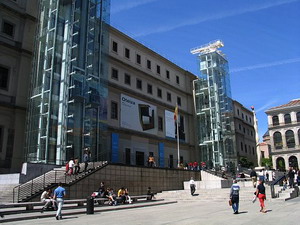 The
museum is mainly dedicated to Spanish art. Highlights of the museum include
excellent collections of Spain's two greatest 20th century masters, Pablo
Picasso and Salvador Dalí. Certainly the most famous masterpiece
in the museum is Picasso's great painting Guernica. The Reina Sofía
also has fine collections of the works of Juan Gris, Joan Miró,
Julio González, Eduardo Chillida, Antoni Tàpies, Pablo Gargallo,
Lucio Muñoz, Luis Gordillo, Jorge Oteiza, José Gutiérrez
Solana and many other significant artists. The
museum is mainly dedicated to Spanish art. Highlights of the museum include
excellent collections of Spain's two greatest 20th century masters, Pablo
Picasso and Salvador Dalí. Certainly the most famous masterpiece
in the museum is Picasso's great painting Guernica. The Reina Sofía
also has fine collections of the works of Juan Gris, Joan Miró,
Julio González, Eduardo Chillida, Antoni Tàpies, Pablo Gargallo,
Lucio Muñoz, Luis Gordillo, Jorge Oteiza, José Gutiérrez
Solana and many other significant artists.
Foreign
artists are few, but there are works by Robert Delaunay, Yves Tanguy, Man
Ray, Jacques Lipchitz, Lucio Fontana, Yves Klein, cubist still-lifes by
Georges Braque and a large work by Francis Bacon.
It
also hosts a free-access library specializing in art, with a collection
of over 100,000 books, over 3,500 sound recordings and almost 1,000 videos.
The
central building of the museum was an 18th century hospital. Extensive
modern renovations and additions to the old building were made starting
in 1980. In 1988 portions of the new museum were opened to the public,
mostly in temporary configurations; that same year it was decreed a national
museum. An 8000 m2 (86,000 ft2) expansion costing €92 million designed
by French architect Jean Nouvel opened October 2005. |
|
top
|
 |

